Strategic vs Tactical Procurement: Key Differences


Short-term fix versus long-term success. Cost savings versus risk mitigation. Price and availability versus partnerships, collaboration, and innovation.
If these comparisons catch your eye, you’re in the right place.
Today, we’ll compare strategic and tactical procurement.
And you know what? Mastering the balance between the two can set your organization apart.
This article will break down the differences between strategic and tactical procurement and help you decide when to choose each approach to align with your procurement’s goals and needs.
Let’s start with strategic procurement.
Strategic procurement is a forward-thinking approach that focuses on the long-term goals of your organization.
This method involves thorough analysis, careful planning, and alignment with your organization’s overall strategy.
By emphasizing strong partnerships with suppliers, it ensures quality and creates lasting value.
To reach these goals, strategic procurement includes essential activities such as:
Let’s focus for a moment on the heart of strategic procurement—strategic sourcing.
This means looking beyond just finding the lowest prices and instead selecting suppliers who can ensure stable supply chains, minimize risks, and drive innovation.
Effective strategic sourcing starts with having the latest data on suppliers.
This data helps you find those that match your company’s goals—not just in terms of product quality and price, but also ESG criteria and sustainability.
Additionally, continually assessing supplier performance is key to maintaining high standards.
Gregor Stühler, Co-Founder & CEO at AI-based knowledge platform Scoutbee, recognizes the importance of strategic sourcing for his entire organization:
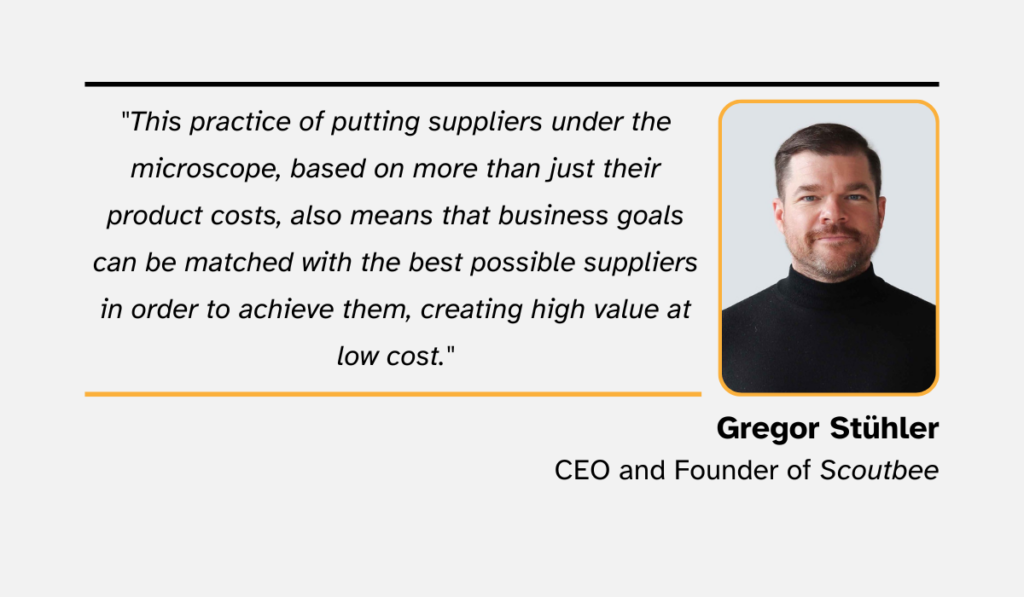
Illustration: Veridion / Quote: Procurement Magazine
However, supporting strategic procurement—and sourcing—requires embracing technology and digital transformation.
Tools like our supplier sourcing enabler, Veridion, the largest global database of suppliers, provide fresh, updated data, making your sourcing process more efficient and aligned with your strategic objectives.
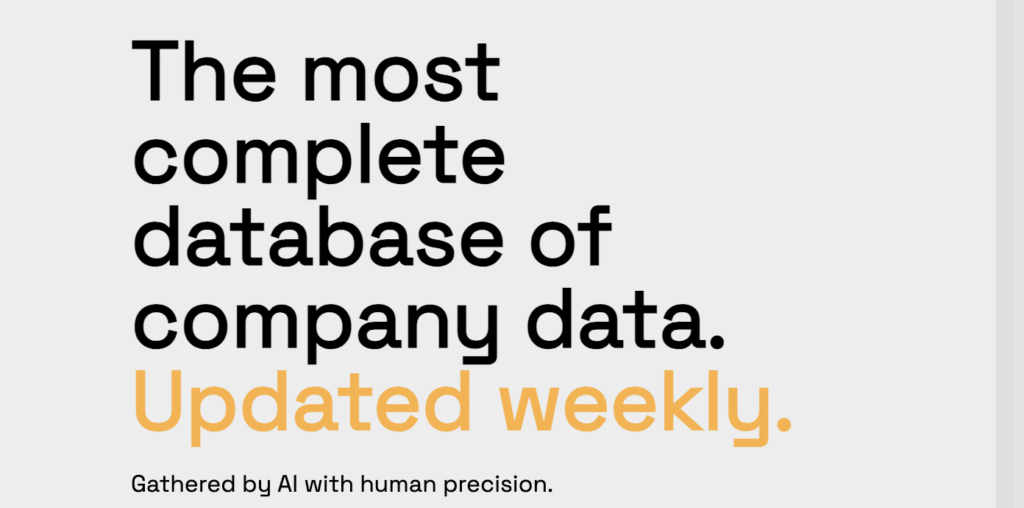
Source: Veridion
With Veridion, you can easily identify suppliers that meet your quality, sustainability, and reliability standards.
All in all, adopting a strategic procurement approach can mitigate risks, enhance your organization’s resilience and adaptability to market changes, and ensure that procurement activities contribute to your company’s broader strategic objectives, driving long-term success.
Now, let’s talk about the other side of the coin—tactical procurement.
Imagine you’re in the midst of a critical project and need materials quickly. In this case, tactical procurement is your go-to strategy.
You don’t have time to analyze the market for the best suppliers who align with your strategic goals.
Instead, you select suppliers based on three factors: price, availability, and delivery time.
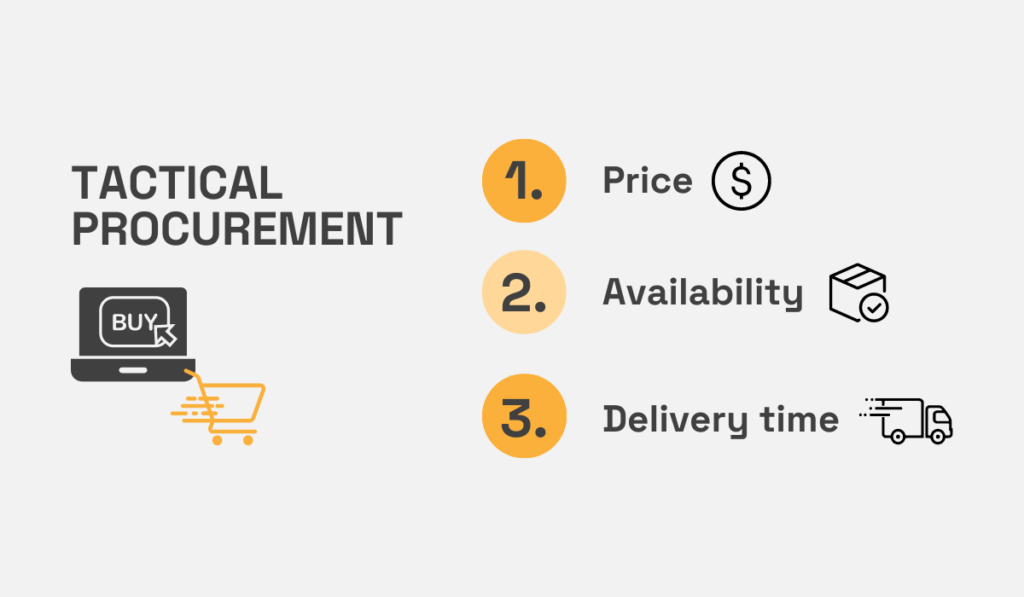
Source: Veridion
In other words, tactical procurement focuses on your immediate needs and short-term goals.
It handles day-to-day activities like placing orders, expediting deliveries, and managing transactions.
While it doesn’t typically involve extensive planning or long-term considerations, it plays a vital role in keeping operations running smoothly.
However, this approach has its drawbacks.
Since tactical procurement doesn’t prioritize understanding suppliers and their capabilities, it can lead to potential issues.
For example, you might purchase materials from a supplier and receive them on time at a good price.
But later, you discover that this supplier uses unethical labor practices.
Although you met your immediate need, this could have negative long-term consequences, such as damaging your company’s reputation and affecting customer satisfaction.
Customers today are increasingly concerned about ethical sourcing and corporate responsibility, and failing to consider these factors can lead to a loss of trust and loyalty.
Thus, while tactical procurement is essential for managing urgent requirements and maintaining operational continuity, it’s crucial to balance it with strategic procurement.
By integrating both approaches, you ensure that short-term solutions do not compromise long-term goals and values.
This balance helps your organization stay agile and responsive while upholding its ethical standards and strategic objectives.
So, what sets these two approaches apart?
The primary difference between strategic and tactical procurement lies in their focus and time horizon.
Strategic procurement is proactive, long-term, and aligned with the organization’s broader goals.
It involves building strong supplier relationships, investing in quality, and considering the total cost of ownership (TCO).
For instance, strategic procurement focuses not only on the initial purchase price but also on factors like maintenance costs, durability, and the supplier’s reputation for reliability.
By considering these factors, strategic procurement can lower the total cost of ownership over the product’s lifecycle.
On the other hand, tactical procurement is reactive, short-term, and centered on fulfilling immediate needs.
It focuses on getting the best price and ensuring timely delivery for current requirements.
Another key difference is in the level of involvement and analysis.
Strategic procurement requires significant upfront investment in research, planning, and relationship management.
It involves collaboration across departments—including finance, operations, and marketing—and often includes high-level decision-makers.
Tactical procurement, however, is more transactional and operational.
It typically involves procurement teams and operational staff who handle the purchasing activities on a daily basis.
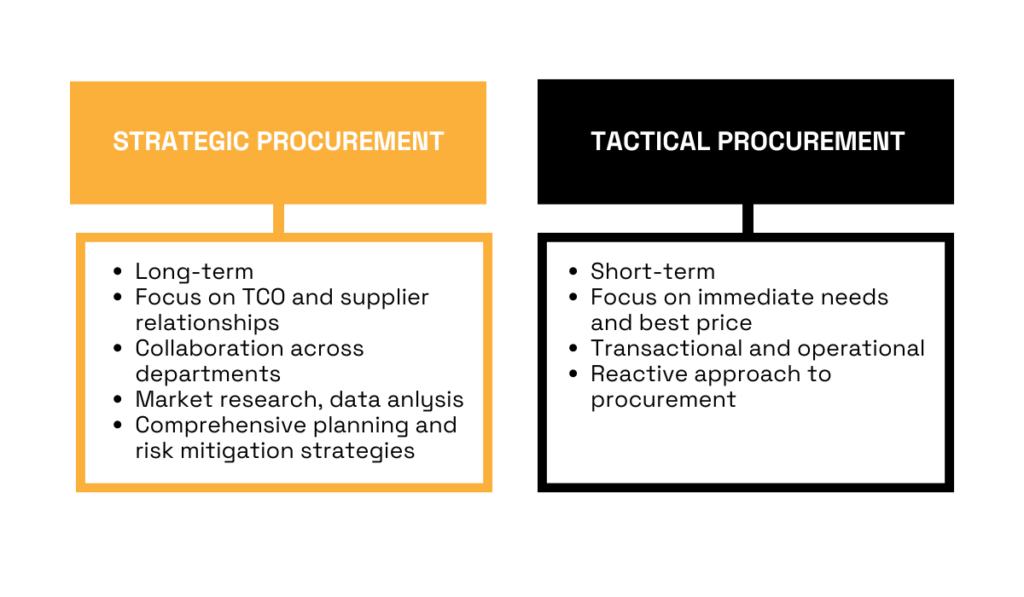
Source: Veridion
Now—what about the outcome of these two approaches to procurement?
Because of its nature rooted in data analysis and strong collaboration with suppliers, strategic procurement often results in more stable supply chains, better quality products, and long-term cost savings.
On the other hand, tactical procurement, while essential for addressing urgent needs, can lead to higher costs in the long run if over-relied upon due to a lack of comprehensive planning and potentially missed opportunities for savings and value creation.
Because it doesn’t prioritize supplier relationship management or risk management, a purely tactical approach leads to missed opportunities for innovation and relationship-building with suppliers and may not address underlying supply chain risks.
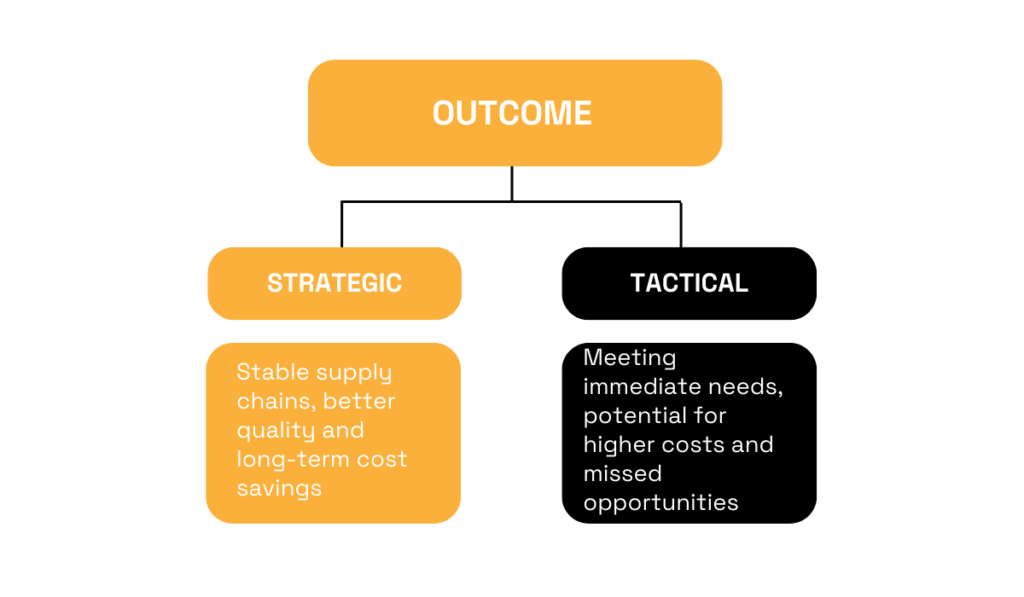
Source: Veridion
Let’s conclude with the explanation of the two by Denis Wolowiecki, Executive Managing Director of CAPS Research, a nonprofit research center for supply management leaders.
He points out that tactical procurement is rightfully necessary, but strategic procurement is the one that can actually bring real value to your company in the long run:
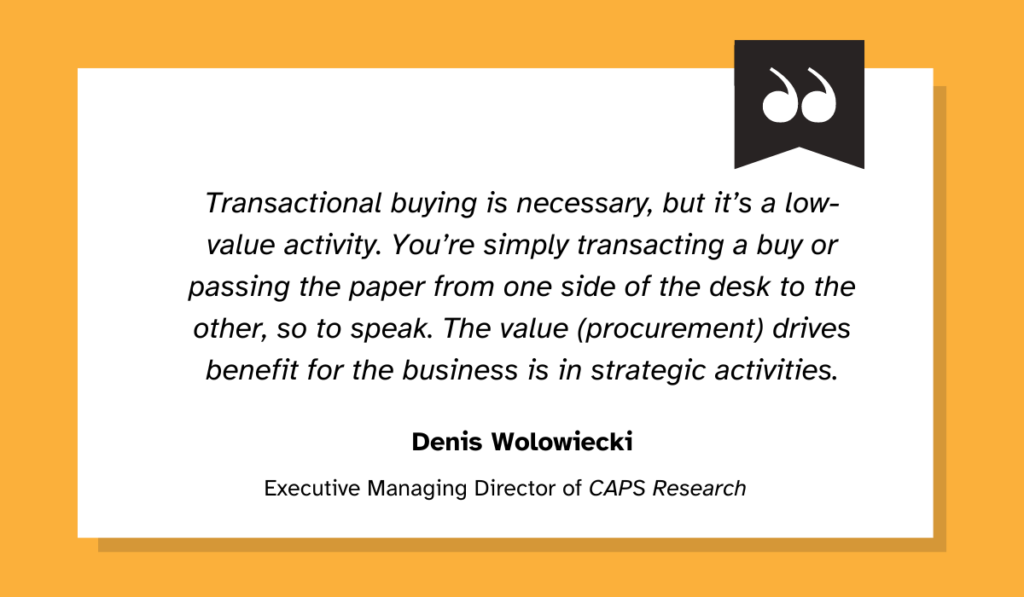
Illustration: Veridion / Quote: Institute For Supply Management
But is it always better to choose strategic procurement over tactical?
Not really, as it all depends on your needs, the size of your company, and a few other factors.
Let’s dive into when to choose strategic and when to choose tactical procurement.
Organizations should opt for strategic procurement when they aim to achieve long-term success and sustainability.
This approach is ideal for industries with complex supply chains, where quality, reliability, and innovation are critical.
For instance, a tech company developing cutting-edge products would benefit from strategic procurement to ensure access to the latest technologies and high-quality components.
Strategic procurement is also advantageous when entering into long-term contracts with key suppliers.
By investing in these relationships, you can negotiate better terms, secure more favorable pricing, and gain a competitive edge.
Additionally, strategic procurement is highly necessary when you want to mitigate risks.
For example, in sectors prone to supply chain disruptions, such as manufacturing or healthcare, having a strategic plan helps manage risks and ensure continuity.
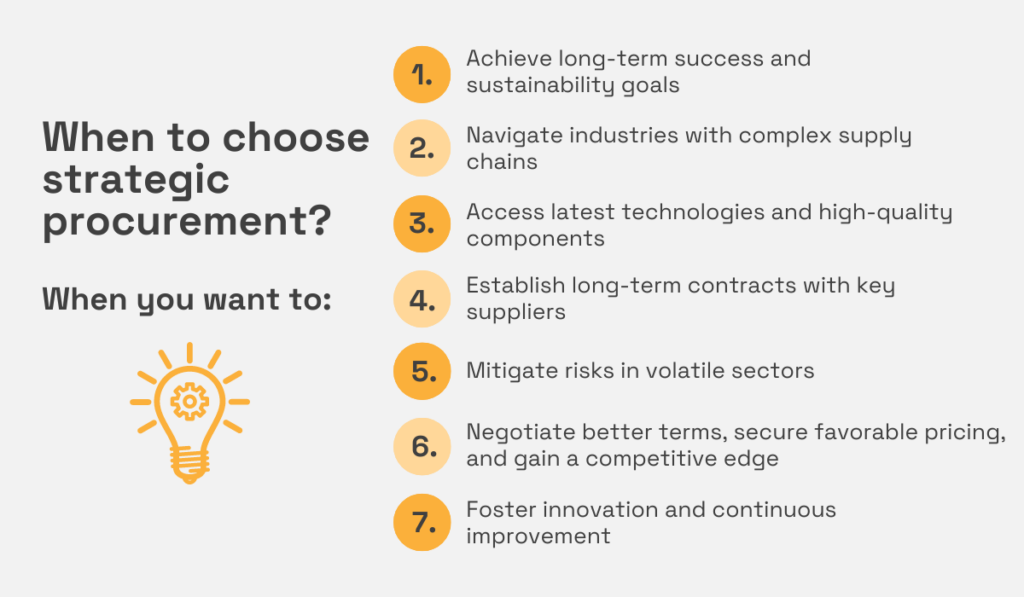
Source: Veridion
Yet, it’s important to acknowledge that strategic procurement demands streamlined processes, technological adoption, data, and skilled talent across departments.
That’s why larger organizations, with their resources and capabilities, are better positioned to integrate strategic procurement practices.
Tactical procurement, on the other hand, is the best choice when the focus is on immediate needs and short-term objectives.
This approach is also suitable for organizations that operate in fast-paced environments where quick decisions and rapid responses are crucial.
For example, in retail, where demand can fluctuate rapidly, tactical procurement allows you to react quickly to changes in customer preferences and stock levels.
Moreover, tactical procurement offers a lifeline for smaller businesses.
They, for instance, may lack the resources for extensive strategic planning.
In such scenarios, tactical procurement ensures access to necessary supplies without the complexity and time investment demanded by strategic approaches.
Moreover, whether you’re a small startup or a large enterprise, tactical procurement enables you to manage unexpected disruptions effectively.
When confronted with sudden supply chain challenges, such as delayed deliveries, you should be agile and choose the tactical approach to quickly identify alternatives and maintain operational continuity.
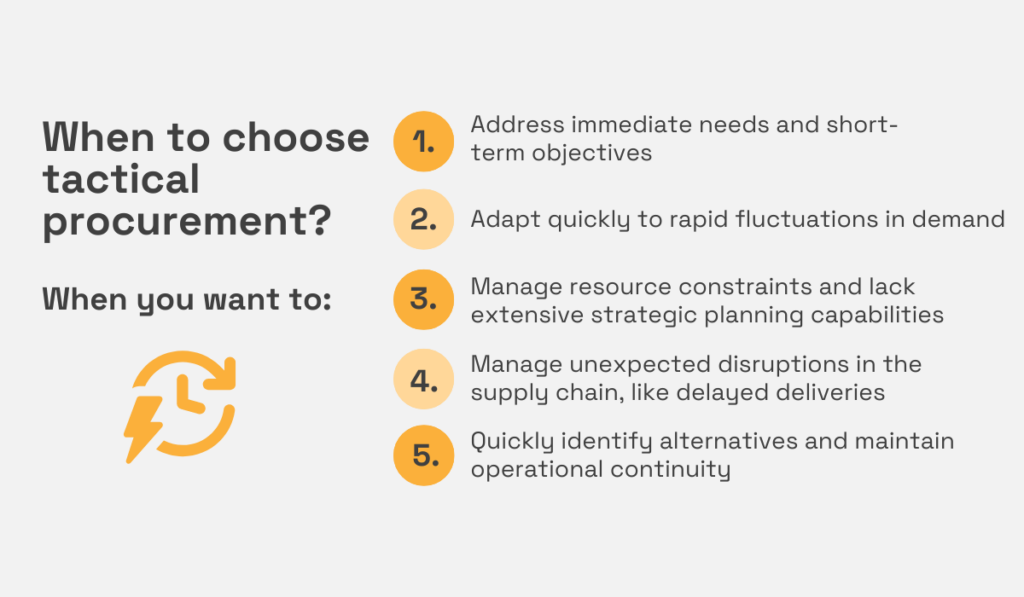
Source: Veridion
However, it’s important to acknowledge the potential drawbacks of over-relying on tactical procurement.
While it excels in addressing immediate requirements, an exclusive focus on tactical procurement can entail higher costs and increased risks over the long term.
Therefore, it’s crucial to strike a balance between tactical and strategic procurement to optimize procurement strategies.
Choosing between strategic and tactical procurement isn’t about picking one over the other.
It’s about knowing when to use each approach.
Strategic procurement offers long-term benefits, stability, and innovation, making it ideal for organizations focused on growth and sustainability.
Tactical procurement, with its emphasis on immediate needs and quick responses, is essential for maintaining day-to-day operations and managing unexpected disruptions.
As a procurement professional, understanding these differences and applying the right approach in different situations is key to optimizing your processes and achieving organizational success.
By leveraging the strengths of both strategic and tactical procurement, you can ensure your organization remains competitive and resilient in an ever-changing market.